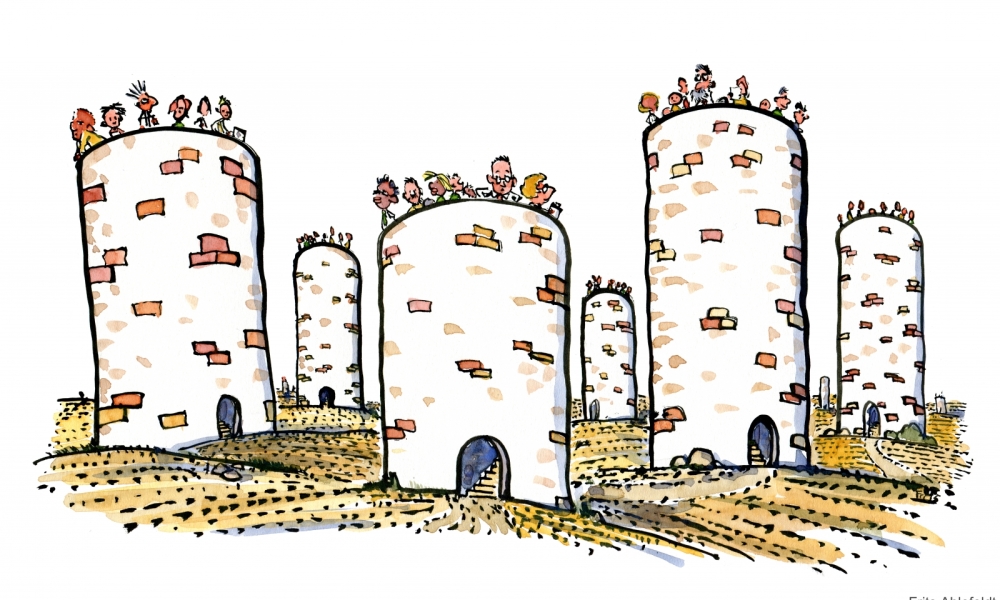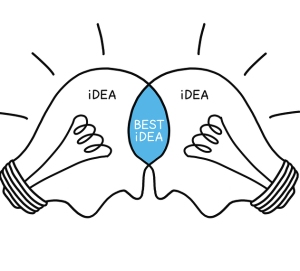When was the last time you had a really good idea?
And where were you when it happened? Some of my best thinking happens on the treadmill. I feel able to focus on an emerging idea or problem without other thoughts getting in the way when I’m running. Ironically I am at my most creative when I am nowhere near my office or classroom.
Creativity is THE most talked about 21st Century skill these days. The World Economic Forum identified Creativity as the number one skill for teams. Studies from IBM and the Harvard Business review single it out as essential for effective leadership.
We know we want our students to be creative (it is in our profile) and we know that collaborative teams are more creative.
So what is the relationship between the two, and how can we encourage teams of teachers and students to collaborate creatively?
This was the topic under discussion in a recent meeting of the PD Dessert group. Our prompt was this episode, from Adam Grant’s hugely popular TED-sponsored podcast, WorkLife. In it, Grant visits the writers room of the Daily Show with Trevor Noah, to explore the ‘creative burstiness’ that takes place when collaboration is properly scaffolded in teams.
Our conversation was framed around these questions:
- How can we encourage creativity within our teams and classrooms?
- Does collaboration always lead to more creativity?
- What are the barriers to creative collaboration and how can we overcome these?
Sharing our thoughts on this podcast and on what we see in our classrooms and team spaces, a number of important principles emerged:
Principle 1: Creativity is more likely when people feel psychologically safe
When there is trust in a group, people feel that it is ok to make mistakes and are more willing to take risks to propose more creative ideas. To create psychologically safe classrooms and offices we need to build playful atmospheres where challenging accepted thinking is welcomed. One practical way to do this is to prioritise trust building and inclusion activities in our meetings and lessons. Protocols such as ‘putting ideas on the table’ so that they can be critiqued in a ‘safe’ way can help with this.
Principle 2: Cognitive diversity leads to creativity
A study in the Harvard Business review showed that teams solve problems faster when they are more cognitively diverse. In short, great minds don’t think alike. When we recruit we should actively seek people who think differently. Ironically studies of recruitment have shown that we intuitively seek out people ‘like us’ and so we need to be intentional in our recruitment practices (aiming for deep-level diversity rather than just different nationalities or skin colour) if we really want our teams to be more creative. When it comes to picking a mentor or critical friend for our PLP we ought to be looking for people who might challenge our usual way of thinking to provoke us to explore new ideas. The connections between diversity and creativity are explored in this excellent article from the BBC. Interestingly diverse teams may be more creative but can find it harder to reach consensus which is why effective leadership of diverse teams is so important.
Principle 3: Structure is the friend of creativity
Counter intuitively, scaffolding and providing a focused goal for the outcomes of a creative project rather than leaving it completely open enhances creativity. Adam Grant explained that the team of writers have an intentionally structured approach to generating, consolidating and refining content for the Daily Show. A great educational example of this is the Japanese model of Lesson Study in which a triad of teachers work together to target an identified area for development in their students’ learning. The team collaboratively research, plan, teach and observe a series of lessons. It is a highly scaffolded framework but has been shown to lead to greater creativity in unit planning.
Principle 4: Deadlines help us to be creative but inflexible timeframes for thinking do not
This apparent contradiction relates to research from Teresa Amabile that suggests that providing no fixed deadline for a creative activity is unlikely to lead to results. Apparently we thrive when there are parameters to the task. However, trying to get a team to be creative when there are constant interruptions is also a problem. A rigid school timetable can make it difficult for teams of students to really immerse themselves in the project. This is perhaps why some schools (like WAB and their FLOW21 project) are breaking free from traditional timetable structures to promote creative thinking in their students.
Principle 5: Remove distractions
Books such as Reclaiming conversation, Unselfie and Learn Better all speak to the value of removing distractions to allow ourselves headspace for daydreaming and creative problem solving. Being able to ping pong between focused thinking and diffuse thinking as a strategy can help us to be more creative too. Apparently Salvador Dali used diffuse thinking to come up with some of his best ideas!
Principle 6: Ring-fence time to focus and don’t be afraid to ‘sit with struggle’
This principle comes straight from writers workshop – a programme used in our junior and middle school English classes. In workshop, students are encouraged to spend extended periods of time simply engaged in their own writing. Some students find this really hard. But helping students to appreciate that some of our best thinking happens when we are not afraid to ‘sit with struggle’ not only builds resilience but also helps them recognise that developing creative ideas can take time.
Principle 7: Make time for conversations at the waterhole
Some of our most creative conversations happen when we take time to connect informally. This idea is explored by David Thornburg who identified learning spaces that promote good thinking and coined the term ‘watering holes’ to describe places where people meet and where informal collaborative conversations happen. Making time to sit and eat together as teams (rather than over our laptops) is not just important for our wellness but also for creativity too. Teachers are not the only ones who frequently skip proper lunch breaks. This article from the World Economic Forum explains why we need to prioritise time at the Watering hole.
Principle 8: Silo thinking can limit creativity
And while we are at it, we need to check out other watering holes too. Working in such a large and complex system as Dover presents challenges but also opportunities. Whilst it is understandable to want to focus on what is going on in our own tower, if we always do so, we may miss the chance for synergistic thinking and ‘collective intelligence’. Often applied to the way that social media has been used to leverage powerful changes in collective culture (for example in attitudes to Marine Pollution or the #Me Too movement) collective Intelligence is the capability of a group to collaborate in order to achieve goals that a smaller group would not be able to accomplish alone. Intentionally looking for ways to connect with people in other teams and schools at Dover not only builds community but is likely to lead to greater creativity.
From this

.. to this

Principle 9: The power of divergent and convergent thinking
Not all creative ideas are good ideas. The design thinking cycle shows the power to be had when groups shift through stages of divergent and convergent thinking as they solve problems. Effective leaders are able to support teams in this process, so that they can creatively brainstorm a range of ideas, but are then able to focus down and agree on the best one to take the team forward. Using a model like this to frame a conversation around, say, planning a unit or common assessment can help teams to be creative in both ‘modes’ of thinking.




Hi Ellie,
Thanks for sharing this thoughtful and resource-rich post.
I love the seventh principle but find it extremely difficult to find the casual chat time here…I wonder if the college needs to look at a “just lunch day,” and consider one day of the week that is reserved just for lunch: no meeting or activities. Surely we could protect just one day?
Anyway to add to your list of resources if you haven’t read “bored brilliant” by Manoush Zamoridi, add it to your TBR list for summer.
Are you at all familiar with Austin Kleon? Every one of his books had been fundamental in shaping my thoughts on Creative processes.
Thanks again,
Tricia
What a fabulous curation of resources! Lots of things to think abut here, most importantly how much work is needed to create opportunities for teams to be really productive. I wonder how this looks in practice at schools who are breaking free from traditional timetables: with so much apparently unstructured time for students, what work is going on behind the scenes to provide the unobtrusive scaffolding necessary for them to be creative.
Thanks for sharing this, one to bookmark!
Ellie I’ve been coming back to this during the week to think and re-read! The strands you pull out here are so valuable, and I particularly like that last point that not all creative ideas will be good ones, and that structures are (perhaps counter-intuitively) at the heart of creativity.
I think the biggest challenges for us here are captured in principles 5-7, and all hint at the need for time: for stillness, for reflection, for conversation, or just ‘incubation’ of ideas. In a school culture which is all go-go-go, how can we find and protect this time, for us and our students? And where’s the tension here with the point above: when might time constraints be part of a structure which stimulates rather than stifles our creativity?
Need to go and check out the podcast now!